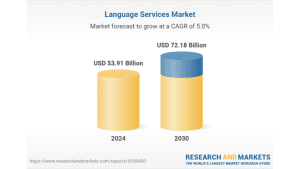May delivered significant developments across healthcare language services. From market milestones to regulatory updates, here’s what shaped our industry this month.
Market Growth & Expansion
$72 Billion Market Milestone
The global language services market is projected to reach $72.18 billion by 2030, fueled by three major drivers: AI and machine translation advancements, explosive demand for multilingual content, and active merger activity among providers. This growth signals robust opportunities for specialized healthcare language services as organizations prioritize professional communication across language barriers.

Healthcare Interpretation Takes Center Stage
Medical interpreter services experienced notable growth this month, particularly in on-site interpretation demand. Healthcare facilities increasingly recognize that real-time, face-to-face communication directly impacts patient safety outcomes. Regulatory requirements continue driving this trend, as organizations seek to meet compliance standards while improving care quality for diverse patient populations.
Industry Employment & Policy
Mixed Employment Outlook for Language Professionals
The US Bureau of Labor Statistics revised job growth expectations for translators and interpreters from 3% to 2%, despite a 5% wage increase to a median annual salary of $59,940. The industry employs about 78,300 professionals, with healthcare interpreters earning around $60,890 annually. While growth appears slower than average, the BLS emphasized that “computers cannot yet produce work comparable to what human translators do in most cases,” reinforcing the irreplaceable value of human expertise.

Canadian Academics Defend Translation Quality
Nearly 70 Canadian academics signed an open letter demanding that the government reverse plans to cut over 300 Translation Bureau positions by 2030. The academics criticized AI justifications for cuts, warning that English-dominant training data may produce French translations “colored by English.” Their concerns highlight ongoing industry debates about maintaining professional standards while integrating new technologies.

Global Health Policy
WHO Recognizes Language Services as Essential
The World Health Assembly concluded its 78th session with landmark decisions directly impacting global healthcare language services. Among key developments including new controlled medicines guidelines and expanded digital health strategies, the Assembly specifically recognized sign language interpreters and Braille literacy as essential assistive technologies. The resolution emphasizes that these services “reduce barriers people with sensory impairments experience to actively participate in society,” reinforcing the critical role of professional language services in healthcare accessibility.
This May reinforced a clear industry message: from market growth to policy debates, professional language services face both opportunities and challenges as the industry balances technological advancement with maintaining human expertise and quality standards.
Questions about professional healthcare interpretation services? We’re here to help: https://thelanguagedoctors.org/


